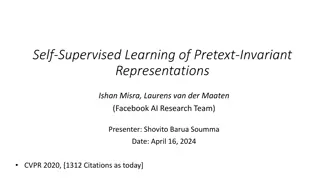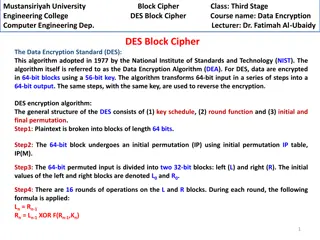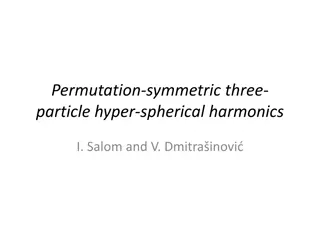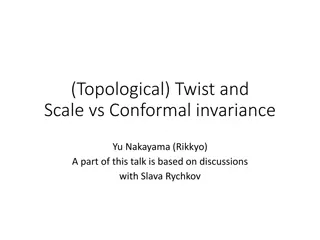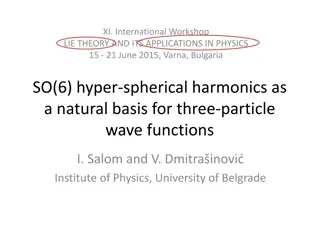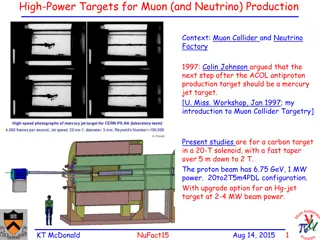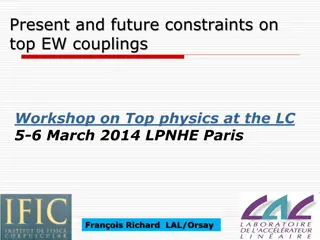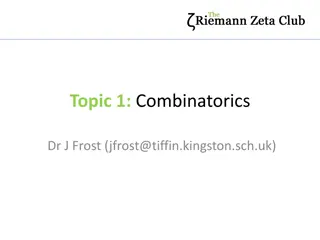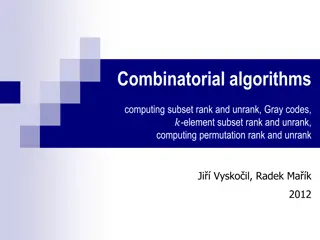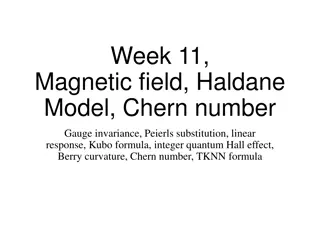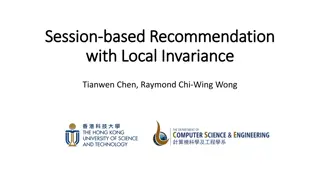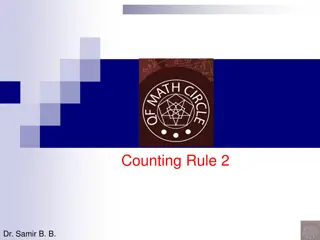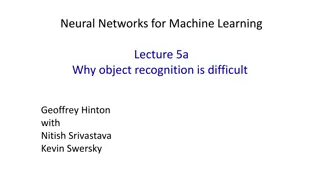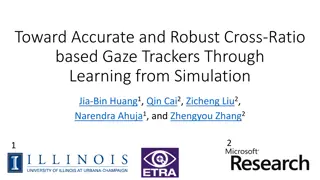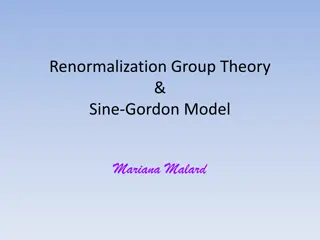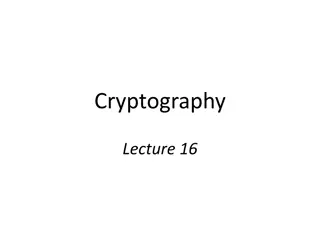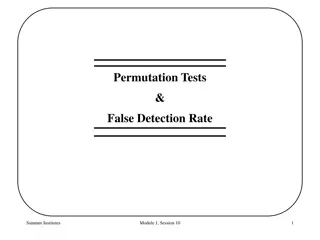Understanding Set Transformer: A Framework for Attention-Based Permutation-Invariant Neural Networks
Explore the Set Transformer framework that introduces advanced methods for handling set-input problems and achieving permutation invariance in neural networks. The framework utilizes self-attention mechanisms and pooling architectures to encode features and transform sets efficiently, offering insig
9 views • 21 slides
Understanding Counting Methods in Probability
This content provides an overview of counting methods for computing probabilities, including combinations and permutations with or without replacement. It explains concepts like permutation with replacement using examples, such as finding possible combinations of letters with repetition allowed. The
0 views • 30 slides
Self-Supervised Learning of Pretext-Invariant Representations
This presentation discusses a novel approach in self-supervised learning (SSL) called Pretext-Invariant Representations Learning (PIRL). Traditional SSL methods yield covariant representations, but PIRL aims to learn invariant representations using pretext tasks that make representations similar for
0 views • 8 slides
Understanding DES Block Cipher in Computer Engineering at Mustansiriyah University
Data Encryption Standard (DES) is a widely used algorithm for encrypting data in 64-bit blocks with a 56-bit key. This course at Mustansiriyah University covers the key components of DES, including the key schedule, round function, and initial/final permutation. Students learn about the encryption p
1 views • 8 slides
Understanding Special Relativity and Its Implications
Explore the key principles of special relativity, including Galileo's principle of relativity and Einstein's principle of relativity. Dive into concepts like length contraction, momentum and energy conservation, and the invariance of mass-energy. Witness how observers inside and outside moving frame
0 views • 18 slides
The Fascinating Journey of Language Acquisition in Children
At birth, infants cannot comprehend or produce speech, but by the age of 4, they have acquired vocabulary and grammatical rules to form various sentence structures. From vocalization to babbling and then to speech, infants progress through distinct stages in language development. Understanding how i
0 views • 32 slides
Hyper-Spherical Harmonics and Multi-Particle Quantum Systems
Explore the application of hyper-spherical harmonics in solving multi-particle quantum systems, focusing on permutation symmetry and splitting wave functions into radial and angular components. The approach involves using center-of-mass reference systems, Jacobi coordinates for different masses, and
0 views • 21 slides
Understanding Invariance in Posterior Distributions
Exploring the insensitivity of posterior distributions to variations in prior distributions using a Poisson model applied to pancreas data. The analysis involves calculating posterior mean and standard deviation with different Gamma prior distributions. Results showcase minimal change in outcomes ac
0 views • 7 slides
Insights into Semiconductor Behavior and Mobility Influence
Understanding the intrinsic and extrinsic behavior of semiconductors with respect to temperature dependence, carrier concentration, and mobility. Exploring the impact of temperature and doping on carrier mobility through lattice and impurity scattering effects. Examining the invariance of Fermi leve
0 views • 8 slides
Understanding Counting Rules and Probability in Mathematics
The content delves into fundamental counting rules such as the Fundamental Counting Rule, Permutation Rule, and Combination Rule to help determine the number of possible outcomes for sequences of events. Factorial notation and permutations are also explained, along with examples to illustrate their
0 views • 24 slides
Understanding Scale vs. Conformal Invariance in Theoretical Physics
Delve into the intriguing concepts of scale invariance and conformal invariance in theoretical physics through discussions on topics such as topological twist, critical phenomena, unitarity arguments, and counterexamples. Explore the fine balance between these two powerful symmetries and their impli
0 views • 19 slides
Applications of Hyper-Spherical Harmonics in Physics
Explore the utility of hyper-spherical harmonics as a natural basis for solving three-particle wave functions in physics, specifically in areas such as atomic physics, molecular physics, and systems involving three quarks. Learn about their role in reducing the complexity of problems, providing mani
0 views • 28 slides
High-Power Targets for Muon and Neutrino Production
Colin Johnson advocated for a mercury jet target as the next step for muon production post-ACOL. Current studies focus on a carbon target with proton beam parameters optimized for muon generation. Carlo Rubbia discussed a potential Muon-Collider Higgs Factory concept at CERN, sparking debate on muon
0 views • 11 slides
Constraints on Top EW Couplings: Workshop on Top Physics at the LC
Workshop on Top Physics at the LC in Paris discussed present and future constraints on top electroweak couplings. The talk indicated how constraints from previous measurements at LEP, Tevatron, and SLC impact realistic expectations. Composite models like Little Higgs play a significant role in top q
0 views • 20 slides
Exploring Combinatorics Fundamentals with Dr. J. Frost
Delve into the realm of combinatorics with Dr. J. Frost as your guide. Discover key topics like slot filling, factorial and permutation functions, distinguishable vs. indistinguishable objects, recurrence relations, compositions, and partitions. Uncover the art of counting and arranging objects with
0 views • 75 slides
Combinatorial Algorithms for Subset and Permutation Ranking
Combinatorial algorithms play a crucial role in computing subset and permutation rankings. These algorithms involve defining ranking functions, successor functions, lexicographic ordering on subsets, and permutation representations. The functions SUBSETLEXRANK and SUBSETLEXUNRANK are used for comput
0 views • 22 slides
Exploring Advanced Topics in Quantum Physics
Dive deep into concepts like the Haldane Model, Chern Numbers, and Linear Response Theory in Quantum Physics. Understand the intricate relationships between magnetic fields, electron Hamiltonians, and conductivity theories. Explore the fascinating world of quantum Hall effects and gauge invariance i
0 views • 15 slides
Enhancing Session-Based Recommendation with Local Invariance Model
Introducing local invariance to Session-Based Recommendation (SBR), the proposed model considers both detailed ordering and high-level session ordering. By explicitly capturing local context information and global sequential patterns, the model outperforms existing methods in predicting the next use
0 views • 19 slides
Understanding Counting Methods: Combinations and Permutations
This content discusses various counting methods for computing probabilities, focusing on combinations and permutations. It explains the concepts of combinations (order doesn't matter) and permutations (order matters) with examples of selection and arrangement scenarios. The distinction between with
0 views • 37 slides
Challenges in Object Recognition for Machine Learning
Understanding the complexities of object recognition is crucial in machine learning. Real scenes present challenges like cluttered backgrounds, varied lighting, deformation, and affordances. Viewpoint changes and input dimension hopping further complicate recognition tasks. Different approaches, suc
0 views • 30 slides
Advanced Gaze Estimation Techniques: A Comprehensive Overview
Explore advanced gaze estimation techniques such as Cross-Ratio based trackers, Geometric Models of the Eye, Model-based Gaze Estimation, and more. Learn about their pros and cons, from accurate 3D gaze direction to head pose invariance. Discover the significance of Glint, Pupil, Iris, Sclera, and C
0 views • 40 slides
Understanding Renormalization Group Theory & Sine-Gordon Model
Get insights into Renormalization Group Theory and the Sine-Gordon Model through lectures covering key concepts such as field theory action, decomposition, Green's functions, model scaling, phase diagrams, symmetries, and phase transitions. Discover how scale invariance and order parameters play a r
0 views • 22 slides
Understanding Block Ciphers in Cryptography
Explore the world of block ciphers in cryptography through topics such as distinguishing attacks, key-recovery attacks, designing paradigms like Substitution-Permutation Networks (SPNs) and Feistel networks, concrete security considerations, confusion/diffusion principles, attack models, and more.
0 views • 27 slides
Permutation Tests and False Detection Rate in HPV Vaccine Trial
Permutation tests are computer-intensive methods used for hypothesis testing when the distribution of the test statistic is unknown. In a hypothetical HPV vaccine trial with 200 women, the scientific question revolves around comparing infection risks in groups receiving the vaccine and placebo. The
0 views • 19 slides
Understanding Randomization and Permutation Tests in Statistical Analysis
Compare treatment effects or means using randomization and permutation tests in independent samples. Learn how these tests work, their procedures, models, algorithms, and applications with examples from NBA and WNBA players' body mass indices and England Premier League matches.
0 views • 20 slides


